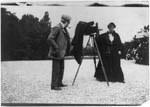Picture Processes: A Chronology

Woman looking at child on floor with broken toy(?). Alexandra Anderson. Woodblock. Ca. 1840. Prints and Photographs Division.
LC-USZC2-1274.
bibliographic record |
The existence of cave paintings testifies to the fact that the impulse to communicate through pictures accompanied the dawn
of humanity. As early as A.D. 55, the Chinese experimented with technologies that expanded the communication potential of
pictures by applying ink to seals and then replicating the designs on such surfaces as fabric, wood, and eventually paper.
Printmaking offered the potential to convey an artist's conception of a subject to many people at once.
By the turn of the fifteenth century, technologies appeared in Europe for relief printing from wood, which made it possible
to reproduce multiple copies of a picture from a single matrix—a woodblock. As the century progressed, further innovation
resulted in the development of intaglio printing processes, such as engraving and etching, where the lines in the print are
produced by ink transferred from below the printing surface, rather than from what is left in relief on the surface.

The Eugenie garter—Manufactured by the American Garter Company. Rae Smith Lith. Between 1840 and 1890. Prints and Photographs Division.
LC-USZC4-5213.
bibliographic record |

Gertrude Käsebier [with unidentified man and camera]. Frances Benjamin Johnston. Undated. Prints and Photographs Division.
LC-USZ62-79067.
bibliographic record |
The commercial potential of image-printing accelerated with the invention in 1798 of still another printing process, lithography, which offered a quick and inexpensive crayon-on-stone method of making multiple copies of an image for direct consumption
by the public and for use in advertising and in illustrating publications.
The development of photography in 1839 offered a seeming departure in image-making. The camera operator still had an influence
on the resulting picture, but the mechanical process of recording the scene before a camera lens, through the use of light
and chemicals, seemed to promise new heights of verisimilitude.
By the late nineteenth century, image producers began to merge the two technologies for making multiple copies of images—printing
and photography—to speed reproduction and to offer new pictorial effects in the form of, for instance, photolithography (patented
in 1858) and halftone photography (first used commercially in magazine illustration in the 1880s).
In this discussion, the term prints refers to images produced primarily with nonphotographic processes, and photographs refers to those using primarily photographic technology.
[Top] |